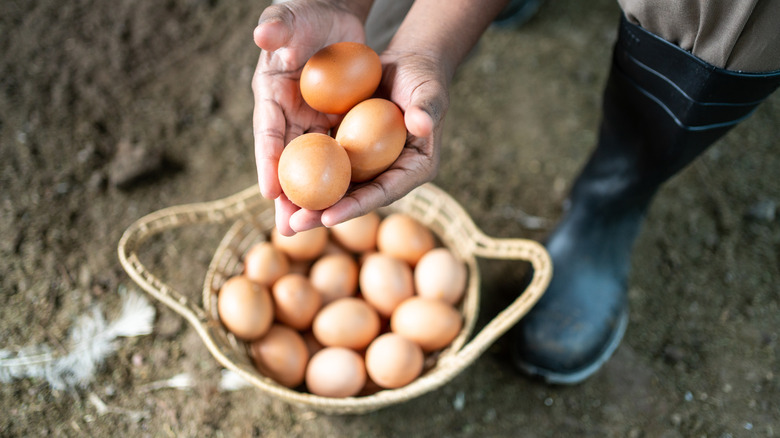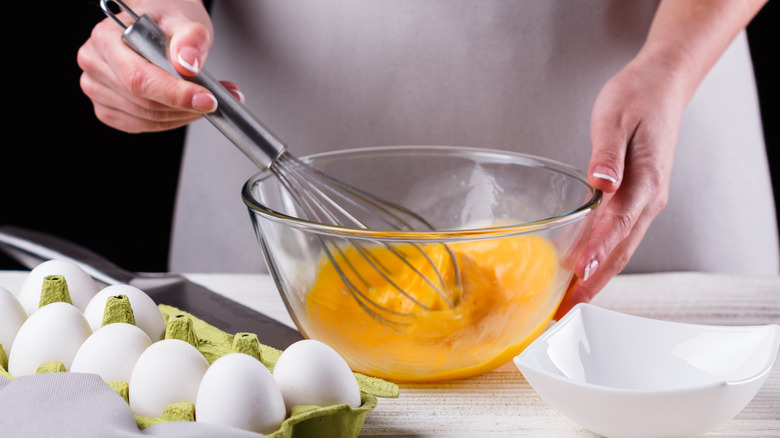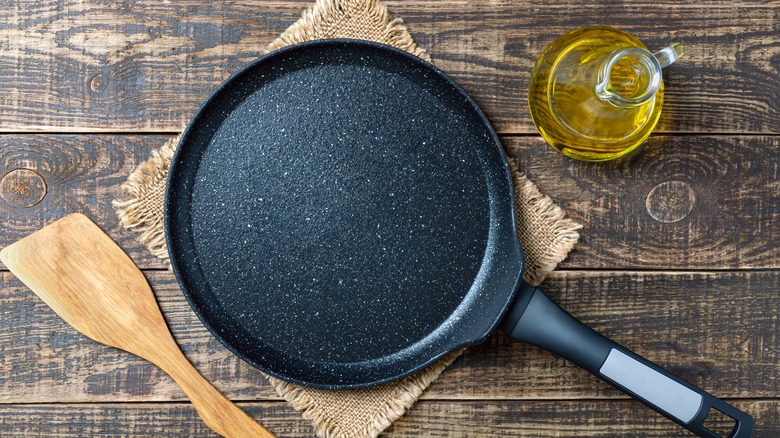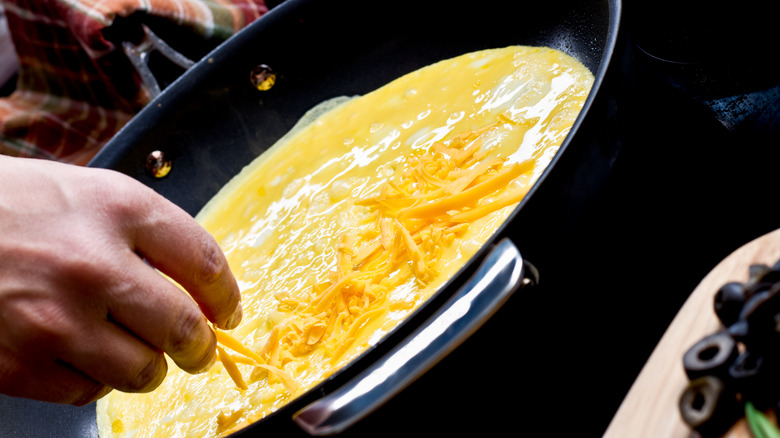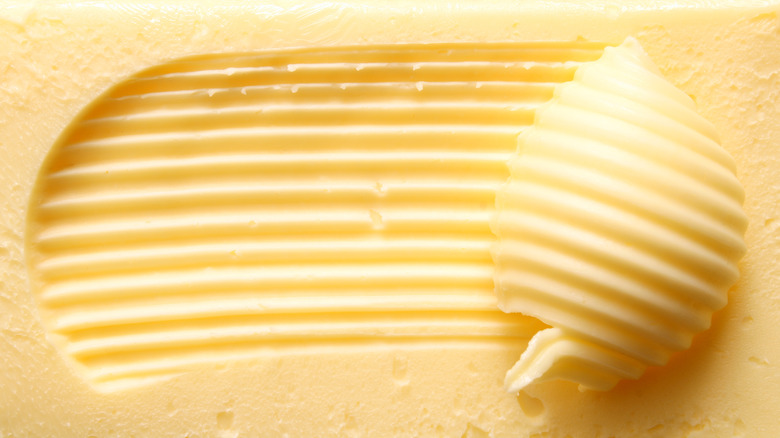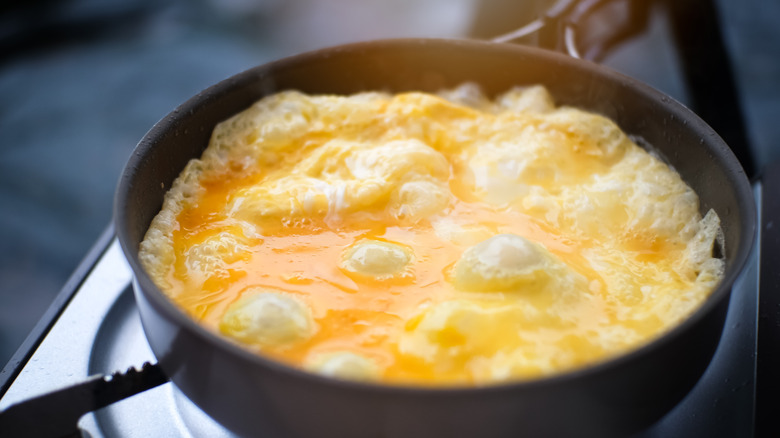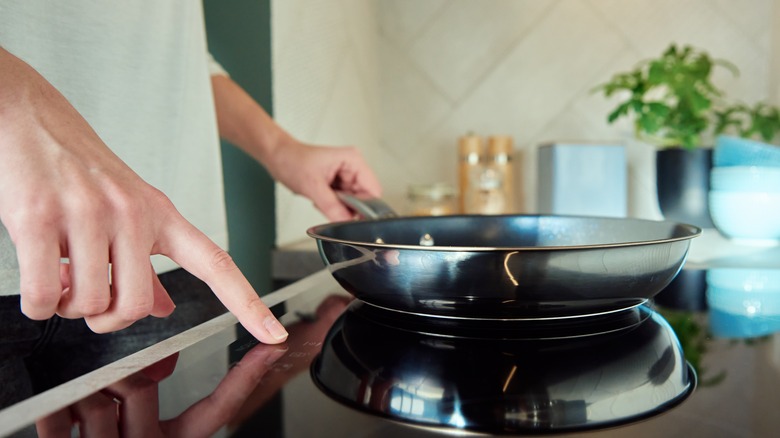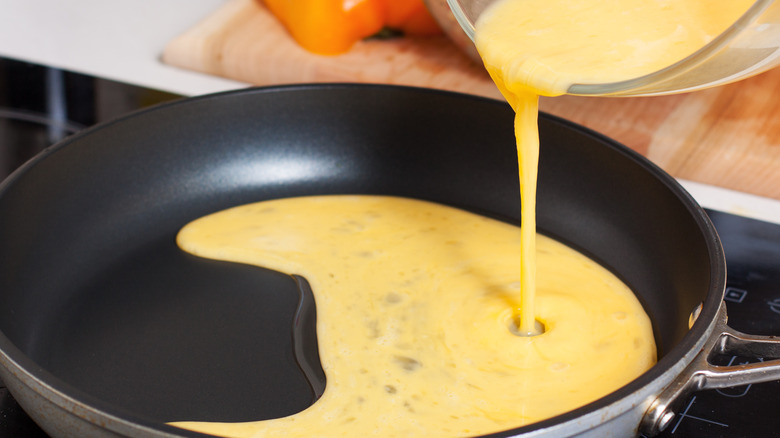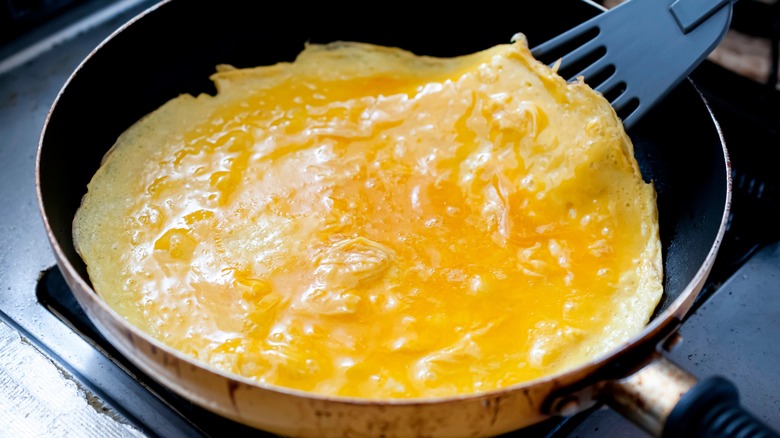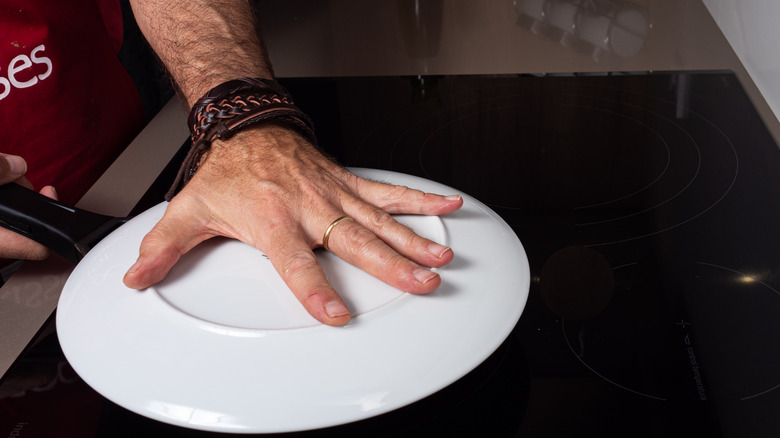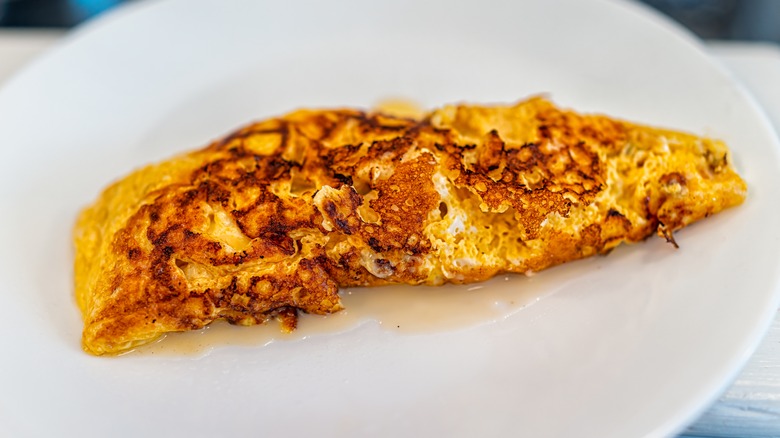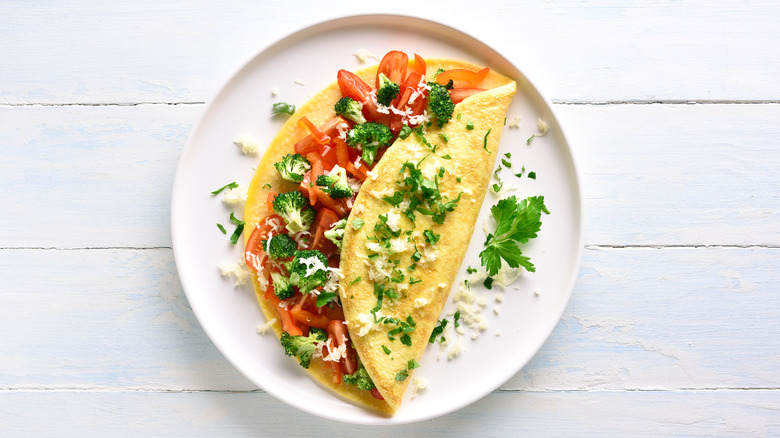13 Mistakes You Need To Stop Making With Omelets
You can't beat a good omelet. The classic egg dish is one of the first things that a lot of people learn how to make in the kitchen and has been for a long time. While the word omelet is French, and the food is commonly prepared in line with France's culinary traditions, omelets have existed in multiple cultures around the world for generations. From ancient Rome to historical Japan, the act of mixing eggs in a bowl and cooking them in a hot pan has been performed by pro chefs and novice cooks alike.
But, somewhat ironically, for such a basic dish, somewhere along the line, omelets started being taken very seriously. Nowadays, omelets are one of the gold standards of cooking, and we can see why — while it's pretty simple to make a good omelet, making a great one takes a lot more skill and finesse. Thankfully, though, you don't need to devote your life to perfecting an omelet to get this dish right. With this guide, you can bypass all of the common mistakes that people make when they cook eggs and serve up a fluffy, tender, perfect omelet every single time.
1. Using the wrong eggs
It all starts with the eggs. It will probably come as no surprise to anyone, but if you're not using good eggs for your omelet, you're going to end up with something pretty bad. Aside from the fat and any toppings you use, your omelet is solely egg, and no amount of additions will change their fundamental quality or make them taste fresh if they're past their prime.
As such, you need to make sure that you're bringing the best eggs possible home from the store. While looking at price is a good indicator of how good the eggs are. Usually, a cheaper product will not be as rigorously produced; it's not the main indicator. Bear in mind that a lot of terms on egg cartons that might make them seem better-quality, like farm-fresh, cage-free, or hormone-free, may be unregulated or else have little actual meaning behind it and, therefore, could just be a marketing trick.
For eggs that you know have come from a source that practices good ethical standards, look for a certified humane or free-to-forage label on the box, which indicates that the chickens that laid them were kept under good conditions. Freshness-wise, you should always look at the best-by date and pick a carton with a date that's still far off. Finally, always make sure you're checking inside the carton before putting it in your cart, so you're not taking home any broken eggs without knowing.
2. Beating your eggs to the wrong consistency
Beating your eggs might seem simple, but getting it just right is a fine balance. Doing it for too long can leave you with a slightly soupy consistency, whereas not beating them for long enough will produce a result where they haven't been incorporated well enough, leaving you with lumpy egg whites and an uneven omelet.
Make sure you're beating your eggs so that they're well-mixed and that air is being introduced to the mixture to fluff it up. The best utensil to use to do this is a whisk, which will help to aerate the mixture, giving it a light consistency. Whisk them for around 30 seconds until things start to look a little foamy.
If you want a pillowy omelet that has a similar consistency to a chocolate soufflé, you can also prepare the mixture by separating the egg whites from the yolks and whipping the whites up until they're stiff. Then, gradually incorporate the yolks before piling the whole mixture into a frying pan and allowing it to cook for a few minutes. The result will be a super-soft, luxurious omelet that's unlike anything you've eaten before.
3. Using an incorrect pan
Making an omelet only requires a few essentials, but your pan is one of them. If you don't have the right type of pan or one that's the right size, the dish can be over before it's even begun. If you want to make things easier for yourself, using a nonstick pan is highly recommended. Eggs have a knack for gluing themselves to the bottom of pans when cooked, and by using nonstick technology, you'll avoid having to scrape them off. If you don't have a nonstick pan, just make sure that you're using plenty of fat to lubricate the cooking surface.
Also of high importance is the size of the pan. An omelet is a one-person dish, so a six- or eight-inch pan will usually be sufficient for making single portions and will give you uniform round edges. However, the size of the pan you use can also depend on how thin you like your omelet. If you prefer a more crepe-like consistency, you can opt for a bigger skillet. Just remember that once in the pan, the egg will usually spread out as far as it's able to, so avoid using a super-large pan — not least because it'll make the egg difficult to flip.
4. Skimping on your prep
Part of the beauty of omelets is that they're quick meals, the kind of thing you can throw together in mere minutes after a long day. But with this quickness comes a need to be as ready as possible. Once your eggs hit the pan, things will cook fast, and if you're not keeping an eye on the mixture and are sidetracked slicing your toppings, you can find that by the time you get back to your skillet, things have overcooked already.
That's why preparing everything before you begin is so important. Slice your toppings and place them into separate bowls next to the eggs, so that when the time comes, you can simply scatter them on. The same goes for seasonings: Make sure that you have everything on hand and easily within reach. And don't forget about your serving plate. Crucially, your eggs will continue to cook even after you've turned off the stove, especially if you're using a pan that retains heat well. By making sure your plate is close at hand, you'll avoid the eggs toughening up and can make sure you're serving it when it's the perfect consistency.
5. Adding milk
To add milk, or not to add milk: That is the question. And while we're paraphrasing one of the theater's greatest lines of all time here, we're pretty sure Shakespeare would agree that it's a query that's on everyone's lips. Adding milk to eggs before scrambling or making an omelet is a hotly-contested topic, but we're here to tell you that for the latter, you should avoid it entirely. By adding milk to an omelet mixture, you essentially dilute the concentration of the eggs. This can mean your omelet doesn't whip up properly, and you get a flat-tasting finished product.
Additionally, adding milk to a hot pan can cause it to curdle, especially if it hasn't been incorporated into your eggs properly. This has the potential to leave you with a lumpy mess. But the main reason that you shouldn't add milk? It's just not necessary. While some people might argue that adding milk gives you a creamier or more luxurious consistency, we'd argue that if you're using top-quality eggs, you shouldn't need to add anything else.
6. Choosing the wrong type of fat
Omelets live and die by the fat that you use. While you'll get a good level of monounsaturated fats from the egg yolks in the omelet mixture, you'll need additional fat in the pan to stop the eggs from sticking and to add flavor. And if you're making a classic omelet, it's best to go with butter. Butter lubricates the pan excellently, providing a barrier between the eggs and the metal — but any fat can do that. The main reason to pick butter is, quite simply, because it tastes the best. Butter has a richness that pairs perfectly with the eggs. It's a match made in heaven.
Understandably, though, you may be a little hesitant to use a high amount of butter, given that it's high in saturated fats. If that's the case, a neutral-tasting vegetable oil, like olive or canola oil, can be a good alternative with more unsaturated fats. Just remember that you won't get that buttery flavor, though. Importantly, too, you should try and avoid any oils that have a significant flavor to them that won't pair well with your eggs, as this will just make your omelet taste a little strange.
7. Trying to go too big
Omelets are the ultimate one-pan meal, and in that pan is a perfectly-sized single portion. But if you've got some friends coming over for brunch, this can create problems. Omelets, by their very nature, need to be cooked one at a time, but this can mean that by the time you've finished the last in a batch, the first one you made can be stone-cold.
For some people, the solution is simple: Get a bigger pan, and make one big omelet before dividing it up into pieces. But we would advise against it. For one thing, making a massive omelet kind of takes away from the joy of having your own perfectly-made portion of eggs. But it also means that it's so much harder to work with the egg mixture while keeping it all in one uniform piece — and it'll be near-impossible to flip. This means that you'll end up, essentially, with scrambled eggs, as the mixture breaks up while you work it. Save yourself the hassle, and make individual portions, covering each one with foil after you've cooked it to keep it warm. Or rethink your menu entirely, and serve a crowd-pleasing egg dish like a frittata, which will cause you way less stress.
8. Cooking at the wrong temperature
Omelets require heat. But a key mistake is using way too much. While you might enjoy seeing your egg mixture bubble up like a volcano when it comes into contact with the hot pan, you won't enjoy what comes after. Too much heat will cause your eggs to cook unevenly, scorching on the surface while remaining undercooked and runny on the inside. And when it comes to flipping the omelet, that means you'll be left with a lot of raw egg splattering everywhere.
Avoid this by using a medium-low heat setting for omelets. Ideally, your eggs will start to cook as soon as they hit the pan, but not too intensely. Remember that the intention with an omelet is to make sure that it cooks through without burning so that when you flip it or fold it in half, the top is almost done. Avoiding using heat that's too intense will also stop your butter from burning or your oil from smoking, which can cause the eggs to taste bitter and charred.
9. Being too hasty
If you're hungry, getting food onto the table is a priority that can overtake pretty much everything else. But in your enthusiasm to get a delicious omelet onto the plate and into your mouth, don't forget to exercise a little patience. If you don't give your pan adequate time to heat up, you could be in for some problems.
As chef and "Iron Chef America" host Alton Brown states, you should give your pan a few minutes on the stove before you add in any oil or butter. "Even a nonstick surface is pocked with microscopic pores that eggs can fill and grab hold of," Brown states via Food Network. This will then make your eggs harder to work with, and the omelet stick to the surface of the pan. By heating the pan properly, though, these pores will seal up as the metal expands, creating a smooth surface for the fat and eggs to work with.
Then, once the eggs are in the pan, make sure you aren't tipping them out when they're still too runny. Your eggs need to be almost completely set, especially if you're using a topping like cheese, which will add a certain amount of gooiness and softness when it melts. If you take them out before they're done, you'll be serving up a lukewarm, liquified omelet that no one will want.
10. Overworking the eggs in the pan
A good omelet is all about technique, and nowhere is the technique more important than when you get your eggs in the pan. There's a fine line between a smooth, fluffy omelet and a plate of somewhat-grainy scrambled eggs. And the difference depends on how much you work your eggs once they've started cooking.
If in doubt, the best thing to do is to err on the side of caution and touch your eggs less than you think. "Pour the eggs into the center of the pan and stir vigorously with a silicone spatula for 5 seconds," says Alton Brown, per Food Network. After you've done that and they start to firm up on the bottom; even up any irregularities in the mixture by lifting the pan and pouring the eggs around until the whole thing is level and circular.
Once you've done this, you should leave your pan and the eggs to do their thing. Allow them to cook without touching them for 10 seconds or so, which will solidify the bottom of the eggs, and cook them through a little more. Continuing to work the eggs at this point will scramble them. Once done, it's time to fold or flip.
11. Messing up the flip
Flipping an omelet is probably the most satisfying moment of the whole cooking experience, but it's also the one where things are most likely to go wrong. One overly-confident move or moment of hesitation, and your omelet will either end up crumpled into the side of the pan or crumpled into a heap on your kitchen floor.
So, if you want to be an omelet pro, and let's face it, who doesn't, you'll need to learn to master the flip. The first thing you'll need is a good nonstick pan and an adequate amount of oil. Without these, your omelet won't be mobile enough in the pan to flip in the first place. While you might be keen to show off your omelet flip to your friends using just the motion of the pan and some wrist action, we'd recommend playing it safe by either using a spatula or a plate.
A spatula is your best friend if you're flipping the omelet in half. Slide it underneath one side of the eggs and gently flip it onto the other side so that it's folded. Remember that your omelet will need to be nearly cooked to do this; otherwise, it'll just break apart. If you want to flip it completely, you can use a wide spatula or grab a plate and slide the omelet onto it. Then, being careful not to burn your hands, flip the omelet back into the pan so that it's raw side down.
12. Overcooking your eggs
Perhaps the cardinal sin of omelet cooking is leaving it to cook for too long. Overcooking an omelet can leave you with a tough, rubbery result that's a chore, rather than a pleasure, to get through. Furthermore, remember that omelets, like any other food, can burn. And a burnt omelet is not good.
Avoiding overcooking your omelet depends on your cooking time and your cooking temperature. Avoid using too high a heat, as this will scorch the bottom of the egg, and cook it for just long enough for the bottom to set and the top to remain a little liquified. Remember that it's entirely fine to take a peek at the bottom of the omelet by lifting a corner of it with your spatula. If it looks like it's starting to brown too much, you've likely got your heat set too high.
If in doubt, you can perform the jiggle test. Give your pan with the omelet in it a shake. If it has a slight jiggle to it, without the liquid going everywhere, it's likely almost ready. If the liquid spreads out when you do this, though, it probably needs a bit more time. Reduce the heat to low, and let it cook through a little more.
13. Trying to add too many toppings
For some people, the joy of an omelet is enjoying the eggs on their own. Well, we're not some people. While a well-cooked omelet doesn't strictly need toppings, it is one of the best vehicles out there for a variety of vegetables, meats, and cheeses. And a few well-chosen additions can take this from being a light meal to a fully-satisfying dinner.
Having said this, it is very easy to get carried away with omelets. And when you go overboard with toppings, things start to fall apart — quite literally. Adding a mountain of toppings can mean that it can be much harder to flip the omelet, and in your zeal to close it together, you may end up breaking it in half.
So, try to act sparingly, however difficult it is to do. Chop your toppings into small pieces, so you're not having to maneuver any large chunks, and only add a handful or so per omelet. After all, you've gone through all the trouble of getting the eggs just right. You don't want to fall at the final hurdle, right?

